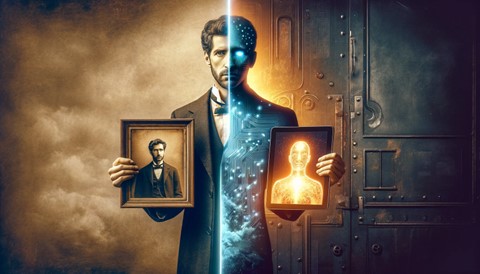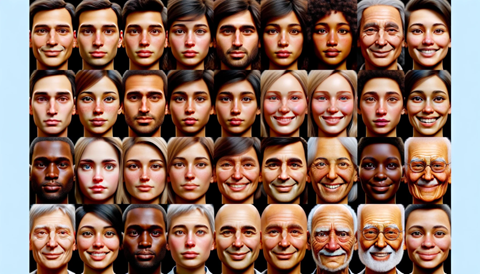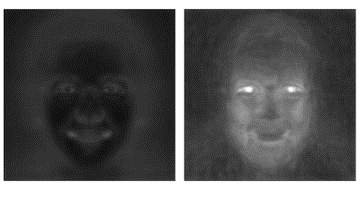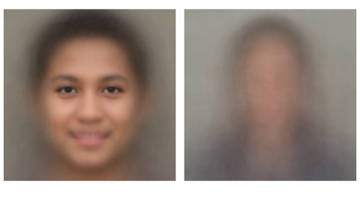- Published on
Photo Forensics & Decoding Deep Fakes in the Age of AI
- Authors

- Name
- Weslen T. Lakins
- @WeslenLakins

In an era where pixels can lie and deepfakes blur the boundaries between fact and fiction, the digital realm demands a new breed of detectives.1 Enter the world of photo forensics, where specialists dissect images with surgical precision, hunting for the elusive truth that lies beneath the surface of AI-crafted illusions.2
Symbolic representation of how "deepfakes" have been an issue in America ever since the invention of the camera.3
Introduction
As pixels paint ever more complex portraits, the role of photo forensics becomes paramount, a guardian of authenticity in a realm where seeing can no longer be equated with believing.4 It stands as a beacon of truth, navigating through the mirage of synthetic imagery that proliferates our visual landscape.5
The veracity of visual media holds more weight in today's interconnected world than ever before.6 With the power to shape opinions, forge narratives, and influence the collective consciousness, the images we consume carry a burden of trust.7 Photo forensics emerges as a critical discipline, ensuring the integrity of this visual dialogue and safeguarding the sanctity of digital truth.8
The Evolution of Image Creation

The odyssey from tangible negatives to ephemeral pixels traces humanity's relentless pursuit of artistic liberation and control.9 This chronicle is marked by milestones of innovation, from the grainy beginnings of film to the precision of digital photography and beyond.10 Each step in this evolution has expanded the horizons of what can be captured, created, and shared, catapulting imagery into a new realm of boundless possibilities.11
Old photo showing the history of propaganda. Soviet secret police official Nikolai Yezhov, pictured to the right of Joseph Stalin, was later removed from this photograph. (Credit: Fine Art Images/Heritage Images/Getty Images & AFP/GettyImages)12
Yet, with every technological leap, there comes a shadow.13 The democratization of image manipulation tools has led to a proliferation of fabricated realities.14 This digital alchemy, capable of conjuring faces that never were, landscapes never seen, beckons us into a new era of skepticism.15 It challenges the forensic analyst to distinguish between the brushstrokes of reality and the sleight of hand performed by algorithms.16
The Realism of AI-Generated Faces

The chasm between synthetic and authentic human likenesses is narrowing at an unprecedented pace.17 AI's ability to replicate the subtleties of human expression and the complexity of facial features heralds a new dawn of digital realism.18 These faces, born from data rather than flesh, can smile, frown, and wink with a lifelike grace that belies their virtual genesis.19
As AI-generated faces become more prevalent, their impact is felt across society – from the realms of entertainment to the spheres of law enforcement and beyond.20 The implications for identity theft, privacy, and security are profound, pressing upon us the need for vigilant and sophisticated methods of verification.21 The forensic analyst must now decipher not just images, but the very essence of human identity encoded within them.22
Photo showing the wide range of facial expressions AI is able to mimic.23
Challenges in Photo Forensics
The task of photo forensics in the face of AI's prowess is akin to a game of shadows, a pursuit where the prey is the truth itself, shrouded in digital veils.24 The conventional tools once wielded by analysts now falter against the sophistication of AI's creations.25 The intricate fabric of AI-generated images leaves behind fewer threads for forensic experts to unravel, challenging them to refine their craft.26
This evolution necessitates a shift in perspective, a reimagining of the forensic toolkit.27 It requires the incorporation of machine learning and AI into the forensic process itself, crafting an arsenal that evolves in tandem with the technologies it seeks to investigate.28 As AI refines its ability to mimic reality, forensics must adopt a chameleon's guise, continually adapting to the ever-changing landscape of digital deceit.29
The digital cat-and-mouse game extends beyond the mere detection of anomalies; it encompasses a broader understanding of the context, the creation process, and the intended narrative of the image.30 Forensic experts are now required to think like the very algorithms they seek to expose, predicting the next evolution of AI-generated falsities.31 This demands a fusion of artistic sensibility with scientific rigor, enabling analysts to discern the subtlest of digital brushstrokes that suggest manipulation.32
Moreover, the rapid pace at which AI is evolving presents a unique challenge: the half-life of forensic techniques is shrinking.33 Techniques that could detect yesterday's AI-generated images may be obsolete tomorrow.34 This accelerates the need for continuous research and development within the field of photo forensics and for a proactive approach to anticipate and prepare for the next wave of AI sophistication.35
Forensic Techniques for Unveiling AI Artifacts
The pursuit of truth in imagery is a meticulous quest for inconsistencies and anachronisms that betray an image's artificiality.36 Forensic experts have become digital archaeologists, sifting through the layers of an image to unearth signs of tampering.37 They examine the curvature of pixels, the flow of light, and the integrity of shadows to detect the fingerprints of AI.38

Avg. reconstruction error for 400 GAN-generated faces (left) and 400 real profile photos (right). (Credit: Hany Farid)39
Such scrutiny has revealed that AI, despite its advancements, often falters in replicating the chaotic harmony of nature's design.40 The random imperfections, the asymmetries, the complex interdependencies of environmental elements – these are the stanzas of reality's poem that AI struggles to emulate.41 Forensic techniques that detect such discrepancies are crucial, serving as the litmus test for an image's claim to reality.42

The average of 400 GAN-generated faces (left) and 400 real profile photos (right). (Credit: Hany Farid)43
This detective work extends beyond the static image into the realm of video and even three-dimensional renders, where AI's prowess is manifesting with increasing conviction.44 Forensic analysis in these domains becomes even more complex, as movement and depth add additional layers to the puzzle.45 Analysts must now understand and interpret the interplay of light across dynamic scenes, the physics of movement, and the consistency of three-dimensional space to effectively pinpoint inconsistencies.46
The expertise required to navigate this forensic landscape is becoming as technologically advanced as the tools used to create the images under examination.47 Specialists in photo forensics must now possess a deep understanding of machine learning, image processing, and even the nuances of human perception to effectively combat AI's illusory capabilities.48
The Case of Lighting and Shadows
The physics of light and shadow do not bend to the whims of technology; they are constants in an ever-changing digital sea.49 Photo forensics harnesses these constants as anchors, grounding analysis in the immutable laws of optics and perspective.50 When AI-generated images cast shadows that defy the source of light or distort expected patterns, they reveal their synthetic origins.51
This scrutiny extends to the most minute details—the way light wraps around a curve, the softness of a shadow's edge, the depth it suggests.52 These are more than visual cues; they are the subtle language of authenticity.53 When AI fails to converse fluently in this language, forensic analysis deciphers the discrepancies, reconstructing the scene to confirm or contest its claim to reality.54
The forensic analysis of shadows and lighting also extends to color science, where the spectrum of light reflected by surfaces must correspond with the physics of illumination.55 Color temperature and the way light diffuses across different materials can provide significant clues about an image's authenticity.56 AI often struggles with these subtleties, defaulting to approximations that, while convincing at a glance, do not hold up under forensic scrutiny.57
It is this intersection of art and science, where forensic experts apply a blend of aesthetic judgment and scientific analysis, that the battle for authenticity is waged.58 The fidelity of shadows and the nuances of light become not just visual elements but forensic evidence, critical in the determination of an image's provenance.59
Reflections: A Window into Forensics
In the reflective surfaces of an image, there lies a well of forensic insight.60 Reflections serve as a canvas upon which the laws of physics paint, providing a mirror to the world that must remain untainted by digital manipulation.61 The angles, the clarity, and the congruence of reflections with their source are the keystones of forensic examination.62
Through the discerning eye of forensic analysis, reflections reveal the secrets they contain.63 They can confirm the authenticity of a moment captured or expose the artifice of a scene constructed.64 As generative AI grows more adept, it is the veracity of reflections—how they adhere to or deviate from reality—that remains a bastion of forensic inquiry.65
Beyond mere geometry, the quality of reflections—such as their clarity, distortion, and the way they interact with the materials they reflect—can provide a wealth of information to the forensic analyst.66 In the case of water, glass, or metallic surfaces, the properties of the reflection may reveal discrepancies that are invisible in the objects themselves.67 AI-generated images often falter in accurately simulating these complex interactions, leaving behind a trail for forensic experts to follow.68
As reflections offer a multi-dimensional puzzle, the tools and techniques to analyze them must be equally sophisticated.69 This often involves simulating the physical environment in which the image is claimed to have been taken and comparing the expected reflections with those present in the image, a meticulous process that combines elements of physics, optics, and digital imaging.70
Generative AI and the Future of Photo Forensics
As we venture further into this digital labyrinth, the interplay between generative AI and photo forensics becomes a dance of light and shadow, a delicate balance between creation and detection.71 With each step forward, we traverse into a future where these digital entities are not adversaries but co-creators of a new visual language.72
The implications of this partnership are profound, extending beyond the confines of image analysis into the fabric of our social contract.73 As the capabilities of generative AI expand, so do the ethical considerations and the responsibility of those who wield these tools.74 The future of photo forensics, therefore, is not just a technical challenge but a societal imperative, demanding rigor, ethics, and an unwavering commitment to the truth.75
This burgeoning field demands a symbiotic relationship between technology and technique.76 As AI-generated images become more sophisticated, the nuances of their creation are increasingly encoded within layers of data that require advanced algorithms to decipher.77 Forensic specialists are thus turning to AI itself—not just as an adversary but as an ally—to sift through these layers and identify the digital DNA of an image.78
In contemplating the future of this dynamic field, it becomes evident that the growth of photo forensics will likely parallel the trajectory of AI.79 The discipline must evolve from a reactive stance to a predictive and preventative framework, employing the latest advancements in AI to stay ahead in the perpetual game of digital truth and deception.80
Conclusion
Our odyssey through the digital panorama culminates in a recognition of the symbiotic relationship between AI and photo forensics.81 This partnership, fraught with challenges, is also ripe with potential.82 As custodians of this digital realm, it falls upon us to nurture a landscape where creativity flourishes while truth remains sacrosanct.83
The quest for authenticity in the age of AI-generated imagery is a testament to our unyielding pursuit of truth.84 It is a journey that transcends the binary of zeros and ones, touching the very essence of what it means to be human in a world increasingly mediated by machines.85 As we chart this course, the anchor of forensic science remains our guide, ensuring that in our search for beauty, we do not lose sight of what is real.86
Footnotes
Christos Doukas M., et al., Head2Head++: Deep Facial Attributes Re-Targeting, 3 IEEE Transactions on Biometrics, Behavior, and Identity Science 31 (2021). ↩
Zakharov E., et al., Few-Shot Adversarial Learning of Realistic Neural Talking Head Models, Proceedings of the IEEE/CVF International Conference on Computer Vision (ICCV), 2019. ↩
Wang T-C., et al., Few-Shot Video-to-Video Synthesis, Advances in Neural Information Processing Systems (NeurIPS), 2019. ↩
Zahid Akhtar, Deepfakes Generation and Detection: A Short Survey, J. Imaging 9(1):18 (2023). ↩
Mathias Ibsen, et al., Handbook of Digital Face Manipulation and Detection: From DeepFakes to Morphing Attacks (2021). ↩
Davide Cozzolino & Luisa Verdoliva, Multimedia Forensics Before the Deep Learning Era, in Handbook of Digital Face Manipulation and Detection (2021). ↩
Pavel Korshunov & Sébastien Marcel, The Threat of Deepfakes to Computer and Human Visions, in Handbook of Digital Face Manipulation and Detection (2021). ↩
Matteo Ferrara & Annalisa Franco, Morph Creation and Vulnerability of Face Recognition Systems to Morphing, in Handbook of Digital Face Manipulation and Detection (2021). ↩
Yuxin Wang, et al., Talking Faces: Audio-to-Video Face Generation, in Handbook of Digital Face Manipulation and Detection (2021). ↩
Diego Gragnaniello, et al., Detection of AI-Generated Synthetic Faces, in Handbook of Digital Face Manipulation and Detection (2021). ↩
Hanxiang Hao, et al., Deepfake Detection Using Multiple Data Modalities, in Handbook of Digital Face Manipulation and Detection (2021). ↩
Tripathy S., et al., FACEGAN: Facial Attribute Controllable Reenactment GAN, IEEE Winter Conference on Applications of Computer Vision (WACV), 2021. ↩
Gafni O., et al., Single-Shot Freestyle Dance Reenactment, Proceedings of the IEEE/CVF Conference on Computer Vision and Pattern Recognition (CVPR), 2021. ↩
Gu K., et al., FLNet: Landmark Driven Fetching and Learning Network for Faithful Talking Facial Animation Synthesis, Proceedings of the AAAI Conference on Artificial Intelligence, 2020. ↩
Lee J., et al., MetaPix: Few-Shot Video Retargeting, International Conference on Learning Representations, 2020. ↩
Sanchez E., & Valstar M., A Recurrent Cycle Consistency Loss for Progressive Face-to-Face Synthesis, Proceedings of the IEEE International Conference on Automatic Face and Gesture Recognition, 2020. ↩
Lee C-H., et al., StyleRig: Create Portrait Images of Faces with a Rig-Like Control over a Pretrained and Fixed StyleGAN via 3D Morphable Face Models, 2021. ↩
J. Imaging | Free Full-Text | Deepfakes Generation and Detection: A Short Survey, J. Imaging 9(1):18 (2023). ↩
Deep Learning for Deepfakes Creation and Detection: A Survey, arXiv, 2021. ↩
The Spiral of Digital Falsehood in Deepfakes, International Journal for the Semiotics of Law, 2021. ↩
Electronics | Free Full-Text | UFCC: A Unified Forensic Approach to Locating Tampered Areas in Still Images and Detecting Deepfake Videos by Evaluating Content Consistency, Electronics 13(4):804 (2024). ↩
Deepfake Detection with Deep Learning: Convolutional Neural Networks versus Transformers, arXiv, 2023. ↩
Electronics | Free Full-Text | A Comprehensive Review of DeepFake Detection Using Advanced Machine Learning and Fusion Methods, Electronics 13(4):804 (2024). ↩
Deep Fake and Digital Forensics | IEEE Conference Publication, IEEE Xplore, 2021. ↩
Preliminary Forensics Analysis of DeepFake Images, arXiv, 2021. ↩
Deepfake Detection: A Systematic Literature Review, IEEE Journals, 2021. ↩
Deepfake-Image Anti-Forensics with Adversarial Examples Attacks, Future Internet 13(11):288 (2021). ↩
Artificial Intelligence, Deepfakes, and Disinformation: A Primer, RAND Corporation, 2021. ↩
Deepfake Detection in Digital Media Forensics, ScienceDirect, 2021. ↩
Increasing Threat of DeepFake Identities, Homeland Security, 2021. ↩
Deep Insights of Deepfake Technology: A Review, arXiv, 2021. ↩
Digital Image Forensics: Lessons in Tampering and Fake Image Detection, eforensicsmag.com, 2021. ↩
Don't Trust Your Eyes: Image Manipulation in the Age of Deepfakes, Frontiers, 2021. ↩
From Deepfake to Deep-Useful: Risks and Opportunities through a Systematic Literature Review, arXiv, 2021. ↩
A Forensic Evaluation Method for DeepFake Detection Using DCNN-Based Approach, ScienceDirect, 2021. ↩
Assessment Framework for Deepfake Detection in Real-World Situations, jivp-eurasipjournalopen.com, 2021. ↩
Providing Detection Strategies to Improve Human Detection of Deepfakes, ScienceDirect, 2021. ↩
Are Watermarks Bugs for Deepfake Detectors? Rethinking Proactive Forensics, arXiv, 2021. ↩
Deepfake-Image Anti-Forensics with Adversarial Examples Attacks, MDPI, 2021. ↩
Handbook of Digital Face Manipulation and Detection: From DeepFakes to Morphing Attacks, 2021. ↩
Deepfake Detection: A Systematic Literature Review, IEEE Journals, 2021. ↩
Artificial Intelligence, Deepfakes, and Disinformation: A Primer, RAND Corporation, 2021. ↩
Deep Learning for Deepfakes Creation and Detection: A Survey, arXiv, 2021. ↩
Deepfake Detection with Deep Learning: Convolutional Neural Networks versus Transformers, arXiv, 2023. ↩
A Literature Review and Perspectives in Deepfakes: Generation, Detection, and Applications, International Journal of Multimedia Information Retrieval, 2021. ↩
UFCC: A Unified Forensic Approach to Locating Tampered Areas in Still Images and Detecting Deepfake Videos, Electronics 13(4):804 (2024). ↩
Handbook of Digital Face Manipulation and Detection: From DeepFakes to Morphing Attacks, 2021. ↩
The Spiral of Digital Falsehood in Deepfakes, International Journal for the Semiotics of Law, 2021. ↩
Deepfake Detection: A Systematic Literature Review, IEEE Journals, 2021. ↩
A Comprehensive Review of DeepFake Detection Using Advanced Machine Learning and Fusion Methods, Electronics 13(4):804 (2024). ↩
Deepfake Detection with Deep Learning: Convolutional Neural Networks versus Transformers, arXiv, 2023. ↩
Deep Learning for Deepfakes Creation and Detection: A Survey, arXiv, 2021. ↩
UFCC: A Unified Forensic Approach to Locating Tampered Areas in Still Images and Detecting Deepfake Videos, Electronics 13(4):804 (2024). ↩
Providing Detection Strategies to Improve Human Detection of Deepfakes, ScienceDirect, 2021. ↩
Are Watermarks Bugs for Deepfake Detectors? Rethinking Proactive Forensics, arXiv, 2021. ↩
Deepfake-Image Anti-Forensics with Adversarial Examples Attacks, MDPI, 2021. ↩
Handbook of Digital Face Manipulation and Detection: From DeepFakes to Morphing Attacks, 2021. ↩
Deepfake Detection: A Systematic Literature Review, IEEE Journals, 2021. ↩
Artificial Intelligence, Deepfakes, and Disinformation: A Primer, RAND Corporation, 2021. ↩
Deepfake Detection in Digital Media Forensics, ScienceDirect, 2021. ↩
Increasing Threat of DeepFake Identities, Homeland Security, 2021. ↩
Deep Insights of Deepfake Technology: A Review, arXiv, 2021. ↩
Digital Image Forensics: Lessons in Tampering and Fake Image Detection, eforensicsmag.com, 2021. ↩
Don't Trust Your Eyes: Image Manipulation in the Age of Deepfakes, Frontiers, 2021. ↩
From Deepfake to Deep-Useful: Risks and Opportunities through a Systematic Literature Review, arXiv, 2021. ↩
A Forensic Evaluation Method for DeepFake Detection Using DCNN-Based Approach, ScienceDirect, 2021. ↩
Assessment Framework for Deepfake Detection in Real-World Situations, jivp-eurasipjournalopen.com, 2021. ↩
Providing Detection Strategies to Improve Human Detection of Deepfakes, ScienceDirect, 2021. ↩
Are Watermarks Bugs for Deepfake Detectors? Rethinking Proactive Forensics, arXiv, 2021. ↩
Deepfake-Image Anti-Forensics with Adversarial Examples Attacks, MDPI, 2021. ↩
Christos Doukas M., et al., Head2Head++: Deep Facial Attributes Re-Targeting, 3 IEEE Transactions on Biometrics, Behavior, and Identity Science 31 (2021). ↩
Zakharov E., et al., Few-Shot Adversarial Learning of Realistic Neural Talking Head Models, Proceedings of the IEEE/CVF International Conference on Computer Vision (ICCV), 2019. ↩
Wang T-C., et al., Few-Shot Video-to-Video Synthesis, Advances in Neural Information Processing Systems (NeurIPS), 2019. ↩
Zahid Akhtar, Deepfakes Generation and Detection: A Short Survey, J. Imaging 9(1):18 (2023). ↩
Mathias Ibsen, et al., Handbook of Digital Face Manipulation and Detection: From DeepFakes to Morphing Attacks (2021). ↩
Davide Cozzolino & Luisa Verdoliva, Multimedia Forensics Before the Deep Learning Era, in Handbook of Digital Face Manipulation and Detection (2021). ↩
Pavel Korshunov & Sébastien Marcel, The Threat of Deepfakes to Computer and Human Visions, in Handbook of Digital Face Manipulation and Detection (2021). ↩
Matteo Ferrara & Annalisa Franco, Morph Creation and Vulnerability of Face Recognition Systems to Morphing, in Handbook of Digital Face Manipulation and Detection (2021). ↩
Yuxin Wang, et al., Talking Faces: Audio-to-Video Face Generation, in Handbook of Digital Face Manipulation and Detection (2021). ↩
Diego Gragnaniello, et al., Detection of AI-Generated Synthetic Faces, in Handbook of Digital Face Manipulation and Detection (2021). ↩
Hanxiang Hao, et al., Deepfake Detection Using Multiple Data Modalities, in Handbook of Digital Face Manipulation and Detection (2021). ↩
Tripathy S., et al., FACEGAN: Facial Attribute Controllable Reenactment GAN, IEEE Winter Conference on Applications of Computer Vision (WACV), 2021. ↩
Gafni O., et al., Single-Shot Freestyle Dance Reenactment, Proceedings of the IEEE/CVF Conference on Computer Vision and Pattern Recognition (CVPR), 2021. ↩
Gu K., et al., FLNet: Landmark Driven Fetching and Learning Network for Faithful Talking Facial Animation Synthesis, Proceedings of the AAAI Conference on Artificial Intelligence, 2020. ↩
Lee J., et al., MetaPix: Few-Shot Video Retargeting, International Conference on Learning Representations, 2020. ↩
Sanchez E., & Valstar M., A Recurrent Cycle Consistency Loss for Progressive Face-to-Face Synthesis, Proceedings of the IEEE International Conference on Automatic Face and Gesture Recognition, 2020. ↩